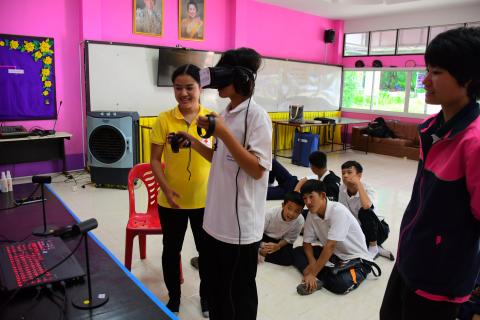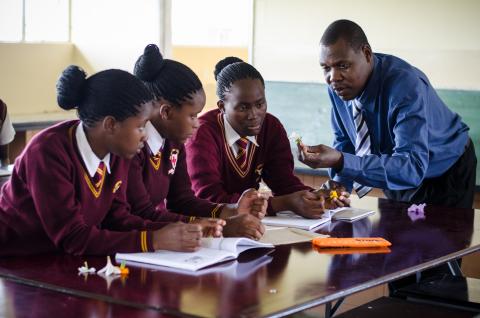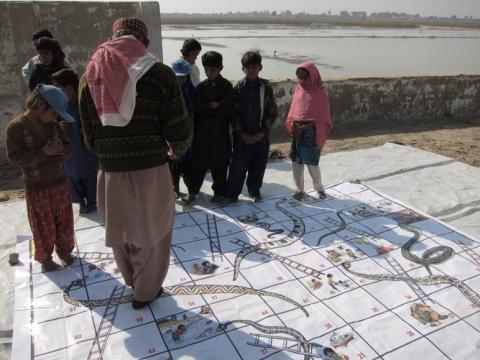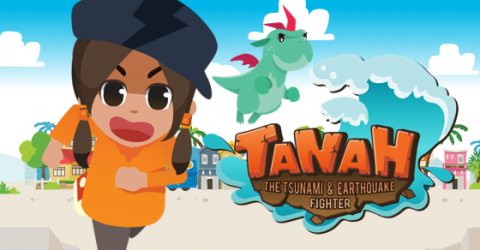10 Key Takeaways from the Immersive Technologies & Digital Games for School Disaster Preparedness Report

The use of virtual reality simulations in a variety of training and pedagogical contexts is expanding, reflective of an upward trend in immersive technologies & digital games’ impact for social good. To embrace this transformative wave, The Global Disaster Preparedness Centre (GDPC) and the American Red Cross commissioned research in 2019 to examine how immersive technologies and serious digital games can help to better support disaster preparedness programming in schools. School-based Disaster Risk Reduction (DRR) training helps children and teachers learn about hazards and practice responding. This includes learning escape techniques through immersion in virtual hazards and emergency situations. XR is particularly helpful to analyze how students and teachers behave in an emergency, raise their level of preparedness, and improve how they respond and cope with hazards.
The research, released in November 2019 in a report Immersive Technologies & Digital Games for School Disaster Preparedness, was designed using semi-structured interviews with over 20 organizations, including XR experts from academic institutions, digital agencies and research consultancies and focal groups. The full report provides a meta-analysis and 10 case studies from across the world with information and varying options useful to any organization interested in pursuing projects that leverage immersive technologies and serious gaming as a disaster preparedness[1] educational tool for schools.
Here we summarize some key takeaways of the research:
1. The technology landscape is complex, but learning is the basic goal
Because the goal of any DRR training is to learn the basics of what to do in an emergency, consideration must be given to the specific characteristics of the audience when selecting the approach or technology, and designing the experience. For example, in some regions or countries, or even varying locations within the same country, you may consider sacrificing quality or detail of graphics to achieve a technological setup that is more basic and simpler to use.
- As you are implemeting in the school context, any educational immersive technology program should have a clear pedagogy or theory of learning in the design.
- The use of technology must not recreate education as it already is but utilize the unique affordances of the technology to bring added value to what is already in practice with other learning modalities.
- The XR experience should be designed and integrated as part of a training module, curriculum or approach, and not as a standalone experience. This aspect should have as much weight as the XR experience design.
- Explore computer-supported collaborative learning where learners performing tasks in groups to achieve shared goals. This is a pedagogical approach which can be applied to educational XR. The ability to facilitate this interaction is claimed by some in the field as VR’s greatest educational potential.
- Adopt an organizational openness to taking risks on new ideas or technologies: this is key for innovation.
2. Experience design is critical
The experience should be designed in participation with target users and include students, teachers, community leaders, local/national government stakeholders, and RCRC volunteers. To ensure the accuracy and relevance of the content and the ability to include the experience into the national Disaster Management curriculum and as part of broader school based DRR training packages, apply a triadic design that balances reality, meaning and play.
- When designing realistic disaster simulations, content should be empowering and follow the principle of self-efficacy.[2] This is the key to overcoming fear in realistically simulated events, coupled with targeting the correct age range.
- Ensure that realistic simulations are age-appropriate, some simulations can be scary or moving for younger audiences. Exercises should also be accompanied by recommendations that are perceived by the recipient as effective towards averting the threat and possible to carry out in the real world.
- Design introductory messages and warnings to prep users on what they should expect. Consider adding special messages for participants who might have had a previous trauma or disaster experience.
- Consider the design differences required for different hazards. For example, earthquake simulations can have much longer and more intricate storylines than fire simulations.
- Forward plan based on forecasted advancements in technology. This is important when working with technologies that are evolving rapidly over a short period of time, to provide options to remain relevant.
- Design with diversity and inclusion as core design principles. This is a responsibility as XR has the potential to have an impact in the real world.
- Implement user testing systems to ensure the design matches the user needs and expectations. Design the experiences following best practices to avoid motion sickness and user discomfort.

3. When designing the experience use existing content and gaming concepts
- Capitalize on content and proven gaming concepts already available in the Red Cross movement. For example, Climate Centre games and Minecraft for community mapping.
- Include a guide in the experience to make the user feel more immersed and integrated. When this is not done, levels of immersion are lower because it is harder to connect with the topic.
- Create a library of shared 3D assets that can be used to build upon and shared across the Red Cross Red Crescent Movement.
4. Consider health, safety and age restrictions
Carefully consider what technology is appropriate for the target audience. Age considerations are important, particularly with immersive technologies, to date this has not been given much prominence in XR used with children.
- Any technology needs to include clearly articulated psychosocial guidance. This should include the age range applicable for the technology and guidance for teachers on how to support students through the experience.
- Any safety warnings developed should include notes about how to use headsets, how to set up a safe space, what are the common risks associated with XR and what to do in case of discomfort.
- Teachers or those promoting this technology must take a cautious approach, drawing on manufacturer health and safety guidelines and the substantial research on child development to make informed decisions about ethical and safe use of the technology.
- Consider privacy implications of using technology with young people and put safeguards in place.
5. Plan for an end-to-end production process
- Regularly check in with the intended learning outcomes during the production process. This is a key design principle to avoid being distracted by the “cool factor” of new technologies.
- User testing is critical, and enough time should be incorporated into the design process for this. As this is an emerging field, any project must be committed to ongoing refinement of the product based on testing with end users.
- Designate a focal point to manage the process, with time built in to their job description.
- Consider the copyright and ownership of the materials and the experience itself, and how they will be safeguarded over time.
- Choose your technology carefully with the goal of creating a scalable project.
6. Plan distribution and sustainability from project inception
- Distribute the XR training as part of a broader curriculum or training package.
- Involve school administrations to ensure wider distribution and overall success.
- Assess how to adapt the experience to other regions, countries or cultures, bearing in mind that translation is not enough – cultural adaptations and customizations are needed.
7. Don’t forget to train the trainers
Despite the critical role that teachers play in keeping students safe and alive in disasters, as shown in the case study of Disaster Scope, very little of the existing tools or literature focuses on DP training and education for teachers. XR and curricula integration would benefit from more research into the most effective way to develop curricula with XR integrated into it and with a full consideration of the instructors to implement this curricula.

8. Not all hazards are created equal
Different hazards require significant design differences and some XR media is more suitable to specific hazards.
It is recommended that additional research be conducted on the specific hazards that the organization would like to focus on.
9. Diversity and inclusion should not be overlooked
Disability and inclusion in XR have been under researched and there is limited guidance on design principles for inclusion. It would be beneficial for organizations to look more into this area c before designing an XR experience.
10. You may need for further research before you can implement XR
More research on gamification techniques may need to be done and tested to identify the most relevant ones for school-based disaster risk reduction. The use of haptic technologies for example should be investigated to assess how much haptic feedback contributes to the simulation experience for disaster awareness and training.
Conclusion
This research underscores the potential for XR to address some of the shortcomings of traditional school based DRR by providing creative, innovative solutions with monumental impact on the quality and reach of disaster preparedness programming. The report recognizes that when working in a space that is constantly advancing and shifting, projections into the future and building experiences should be updated to reflect these advancements. Furthermore, the upcoming convergence of 5G, AI, Internet and VR/AR will enable us to both map our physical world into virtual space and superimpose a digital layer onto our physical environments, with immense new opportunities for all sectors. The potential of this technology should bring great efficiencies to the fields of disaster risk reduction and preparedness. Ultimately, the report concludes that the decision on where to focus XR efforts in DRR education should be guided by priorities in pedagogy, respect for existing well-functioning practices and the realities of the Red Cross Movement, including options and opportunities for scalability. At the same time, these applications will pose a range of ethical, political and economic challenges. This will take the world as we know it and our single biggest mission, to save lives and alleviate human suffering, into another dimension, a new hybrid world.
For the full research go to:
[1] IFRC defines disaster preparedness as: “measures taken to prepare for and reduce the effects of disasters. That is, to predict and, where possible, prevent disasters, mitigate their impact on vulnerable populations, and respond to and effectively cope with their consequences.”
[2] The belief that an individual has on his/her ability to execute a behavior.
Lessons Learned :
Supporting Materials :



